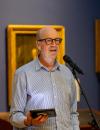Richard Weller (MD, FRCP(Ed))
Personal Chair of Medical Dermatology

- Centre for Inflammation Research
Contact details
Background
I graduated in medicine at St Thomas’ Hospital, University of London (now part of King’s College, London) and undertook my general/internal medicine training in the north of England and in Australia. Having gained my MRCP I trained in dermatology at the Institute of Dermatology (St John’s) in London, and in Aberdeen and Edinburgh. I spent some time out of my clinical training to complete a research MD degree. Having completed my dermatology training, I gained a scholarship from the University of Edinburgh, and spent three years in post-doctoral research training in the laboratories of Prof Victoria Kolb-Bachofen, Heinrich-Heine Universität, Dusseldorf, and of Dr Tim Billiar, University of Pittsburgh, USA.I was recruited from America to the post of Senior Lecturer (latterly Professor) in Dermatology in Edinburgh and am a Principal Investigator at the Centre for Inflammation Research. My time is divided between clinical duties, where I am an honorary NHS Consultant Dermatologist with a particular interest in medical dermatology and eczema, and the University where I have an active research group, with a focus on the effects of sunlight on general health.
CV
Qualifications
MB BS, MD, FRCP(Ed)
Responsibilities & affiliations
Principle Investigator, Centre for Inflammation Research. Honorary Consultant Dermatologist NHS Lothian
Open to PhD supervision enquiries?
Yes
Research summary
Ultraviolet radiation and the skin
In 1996 I made the first description of nitric oxide (NO) production on the skin surface. NO at the time was known to dilate blood vessels and thus help regulate blood pressure - work for which the discoverers received the Nobel Prize for Medicine or Physiology in 1998 - but it was also involved in control of a number of other functions. Initially working in Aberdeen and Edinburgh and then at Heinrich-Heine University, Dusseldorf and the University of Pittsburgh I set out to uncover the role of this naturally produced NO in the skin. Following the standard dermatological dogma of the time I spent my time in Germany and America looking at the effects of NO on keratinocyte (skin cell) survival after sun exposure. Although I was able to show effects of NOS derived NO in inhibiting apoptosis in cell culture and murine models, I was unable to replicate this in man. Developing my work in Edinburgh on healthy volunteers, I was able to show that human skin contains large stores of nitrogen oxides (NOx) and that these are photo-reduced by UV radiation releasing NO to the circulation, with systemic effects, in particular lowering of BP. This work is summarised in a TED talk.
Work from my group and with a number of international collaborators is now finding a growing number of physiological and homeostatic processes that are dependent on this UV-skin NO mobilisation pathway. Partly spurred on by the discovery of this mechanism, the risk-benefit ratio for population sunlight exposure is being reconsidered in Europe, Australia and the USA. It is becoming clear that Vitamin D synthesis is not the only sun-dependent homeostatic mechanism, and may in fact only account for a small part of health benefits attributed to sun exposure. We have recently shown that UVA independently of vitamin D correlates inversely with deaths from COVID, which has important public health implications. Using the UK Biobank we have now shown that for a UK population, increased sunlight exposure correlates with reduced all-cause, cardiovascular and cancer mortality.
